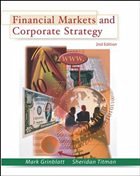Nicht lieferbar

Financial Markets and Corporate Strategy
International Edition
Versandkostenfrei!
Nicht lieferbar
This textbook represents the cutting edge of what the top scholars and practitioners know about finance--at long last made practical and accessible. It is a corporate book, yet it is cutting edge investment theory, presenting the forefront on interpreting what the data says about the theories, cutting edge on risk management, capital budgeting, and on the issues that need to be considered to determine both a firm's proper mix of debt and equity financing and its value maximizing dividend policy. It tells the practitioner/student how to do it and is the first book to teach, with careful step-by...
This textbook represents the cutting edge of what the top scholars and practitioners know about finance--at long last made practical and accessible. It is a corporate book, yet it is cutting edge investment theory, presenting the forefront on interpreting what the data says about the theories, cutting edge on risk management, capital budgeting, and on the issues that need to be considered to determine both a firm's proper mix of debt and equity financing and its value maximizing dividend policy. It tells the practitioner/student how to do it and is the first book to teach, with careful step-by-step pedagogy, and how to think for themselves about it. The goal of this text, and this revision in particular, is to present the material in as simple and accessible manner as possible without glossing over the important details. Rather than organizing the text around financial theory and then thinking about potential applications, the authors began by thinking about finance practice, and then organized the book around the tools needed to create value in the financial management of a corporation.
Table of contents:
Part I. Financial Markets and Financial Instruments 1. Raising Capital 2. Debt Financing 3. Equity Financing Part II. Valuing Financial Assets 4. Portfolio Tools 5. Mean-Variance Analysis and the Capital Asset Pricing Model 6. Factor Models and the Arbitrage Pricing Theory 7. Pricing Derivatives 8. Options Part III. Valuing Real Assets 9. Discounting and Valuation 10. Investing in Risk-Free Projects 11. Investing in Risky Projects 12. Allocating Capital and Corporate Strategy 13. Corporate Taxes and the Impact of Financing On Real Asset Valuation Part IV. Capital Financial Structure 14. How Taxes Affect Financing Choices 15. How Taxes Affect Dividends and Share Repurchases 16. Bankruptcy Costs and Debt Holder-Equity Holder Conflicts 17. Capital Structure and Corporate Strategy Part V. Incentives, Information, and Corporate Control 18. How Managerial Incentives Affects Financial Decisions 19. The Information Conveyed by Financial Decisions 20. Mergers and Acquisitions Part VI. Risk Management 21. Risk Management and Corporate Strategy 22. The Practice of Hedging 23. Interest Rate Risk Management Appendix A. Mathematical Tables
Table of contents:
Part I. Financial Markets and Financial Instruments 1. Raising Capital 2. Debt Financing 3. Equity Financing Part II. Valuing Financial Assets 4. Portfolio Tools 5. Mean-Variance Analysis and the Capital Asset Pricing Model 6. Factor Models and the Arbitrage Pricing Theory 7. Pricing Derivatives 8. Options Part III. Valuing Real Assets 9. Discounting and Valuation 10. Investing in Risk-Free Projects 11. Investing in Risky Projects 12. Allocating Capital and Corporate Strategy 13. Corporate Taxes and the Impact of Financing On Real Asset Valuation Part IV. Capital Financial Structure 14. How Taxes Affect Financing Choices 15. How Taxes Affect Dividends and Share Repurchases 16. Bankruptcy Costs and Debt Holder-Equity Holder Conflicts 17. Capital Structure and Corporate Strategy Part V. Incentives, Information, and Corporate Control 18. How Managerial Incentives Affects Financial Decisions 19. The Information Conveyed by Financial Decisions 20. Mergers and Acquisitions Part VI. Risk Management 21. Risk Management and Corporate Strategy 22. The Practice of Hedging 23. Interest Rate Risk Management Appendix A. Mathematical Tables



